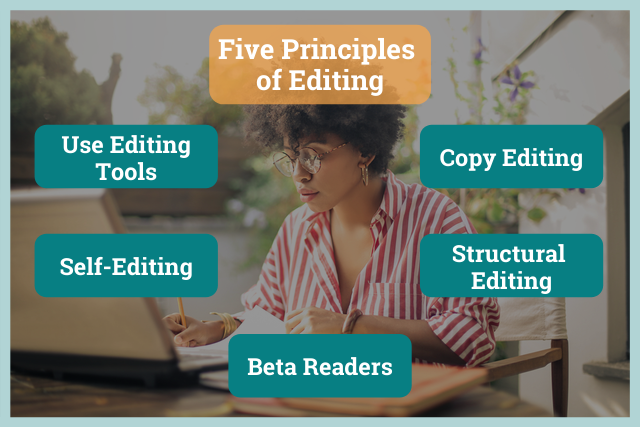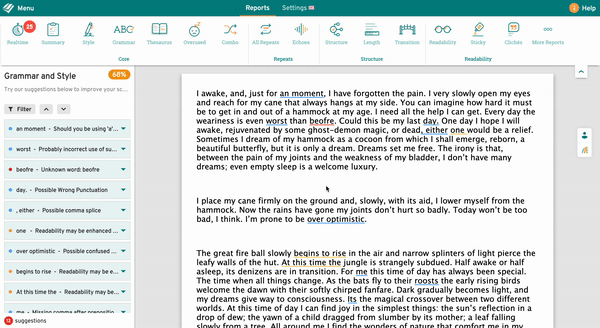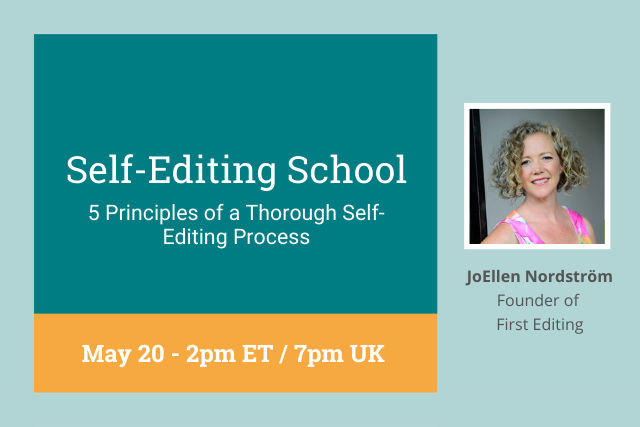Join JoEllen for a live webinar on the 5 Principles of a Thorough Self-Editing Process
Self-edit your book with these five principles used by professional editing services daily. Learn how combining these with effective editorial techniques, online editing tools, and organizational processes helps you publish your book confidently.
Writing a book is a self-fulfilling activity. Self-editing can be equally satisfying when you understand the overall process. When you edit your own book, you perfect your craft and learn to compose a well-written book.
It is always best to hire the services of a professional editor. However, self-editing your book before sharing publicly allows you independently to learn and review the various elements that help make it an ideal manuscript.
How Should You Self-Edit?
Let’s take a deeper dive into this article to learn about thorough self-editing by looking at its five principles.

1. Use Editing Tools
Editing tools help you polish your manuscript. They detect and correct technical writing issues like grammar, sentence structure, spelling, punctuation, consistency, and other elements.
Online editing tools such as ProWritingAid offer basic corrections and style suggestions to help you express your thoughts and intent while writing. Such self-editing tools use artificial intelligence to provide users with ease and speed in editing their writing.
There are several editing tools available online. You can either subscribe to them or test them for free. ProWritingAid allows for different writing styles.
You should use editing tools with caution, however. While they help you craft your book, only use them according to their purpose. Edit only during the book editing stage. This means after the writing process is complete and independent editing is the primary focus.
I recommend you turn editing tools off when you are creatively writing so that they are not distracting your thoughts. Turn them on at the end of your writing session and quickly edit for the day. By doing so consistently, you will learn basic copy editing techniques daily and naturally improve your writing.
ProWritingAid is an excellent copy editing tool, and can even help you with some structural edits too. The ProWritingAid reports correspond with the suggestions real editors would make to improve your writing.
Beyond spelling and grammar, ProWritingAid helps you visualize your sentence lengths, avoid repeated and overused words, assess your pacing, and more.
You can work through suggestions quickly, and get a personalized report on your writing.

You can try ProWritingAid for free below.
2. Start with Self-Editing Basics
First, don’t edit while writing your manuscript. This is one general rule of writing.
Writing differs from editing. Keep the technical editing process separate from the creative writing process. Brainstorm all your thoughts first and write them down without considering grammar issues and other technical writing concerns. This will help you generate all your ideas, allowing you fully to convey your message and express your purposes. The editing process ultimately will address technical writing concerns after you have created your first complete outline.
This rule of when to edit is not compulsory, but it helps you establish good habits in a more passive way each day.
Another rule to follow is to not edit right away after you write.
Take a break from the manuscript and return to it later for the first round of revisions and self-editing. The reason for this is that writing processes require different levels of energy and motivation than editing. Do not edit directly after completing your manuscript. You may only screw up the things you wrote fresh.
Ideally, take a break for a week or so before you slowly begin editing your writing. This way, your mind will be fresh when you edit. It will give you distance and allow you to approach it more independently.
Be sure to avoid the 10 Common Editing Mistakes Authors Make.
3. Enlist Beta Readers
Beta readers are among the most helpful potential tools in the editing process. They can help you find your mistakes honestly. These are people who read your book, helping you catch elementary mistakes, particularly in the plot, pacing, and points-of-view.
If possible, get a minimum of three beta readers to ensure you have enough feedback and suggestions to apply to your writing. Other experts also recommend letting an odd number of beta readers read your manuscript to ensure a split decision of feedback.
Incorporate the beta reader suggestions you agree with during your second revision.
Not sure if you're at the beta-reading stage? Check out our guide to preparing your work to send to beta readers.

4. Focus on Structural Editing & Revisions
Structural editing is the most time-consuming phase of the editing process. It examines the entire picture of your manuscript.
Structural Story Editing for Fiction
In fiction, structural editing pays close attention to the overall presentation, story arc, characters, scenes, plot, and style.
When self-editing, ask questions regarding the purpose and effectivity of your manuscript to help you make corrections. Leave anything you need help with for the professional editor. They will later review and perform a professional structural edit or line edit depending upon your needs.
Do the first two chapters take too long to achieve the essence of the story? If that is the case, skip them and open the scene with the succeeding chapters. How effective is the story when the narrative reveals key elements? Is the end satisfying? Did it give you what you wanted? Did it drag, or was it quick? Is it clear who the characters are and what their intentions are? Are the settings in the story clearly defined?
You can actually use an editing tool such as StoryTeller, which is the industry’s only comprehensive online editing app for a basic self-editing approach. If you are familiar with online software and writing tool technology, you can complete the basic self-editing foundations.
These tools are very helpful to writers, especially in speeding up the editing process of their book. However, it has a learning curve, so those who are not technically proficient may have difficulty using it. Of course, you can always get help whenever you need it.
To create a flawless manuscript, have a professional editor edit it for you. Professionally trained and Certified StoryCoach Editors can complete the in-depth structural edit using the licensed editor version of the online software. Plus, they will give you feedback and publishing insight from their expertise and past success. Conquer the first round of structural editing, then let a professional structural story editor take care of the next stages of professional editing for you.
Structural Editing for Non-Fiction
In non-fiction books, structural editing involves making sure that the audience is engaged and that your writing style appeals to your intended audience. Remember, it is about them and not you. How do they benefit from reading your book?
Always write towards your goal. Are you writing to inspire, motivate, or educate? Are you leading them on your intended journey? Ensure this goal is consistent throughout your book.
Use effective calls-to-action. What do you want the readers to do with the information you are sharing? If you want them to engage with you during or after the book, how are they going to do that? Provide links, contacts, or other information to let them accomplish an action.
Back all your statements with proof or examples. People engage best with stories. Try to emulate similar authors in your genre or area of expertise. That will make your book more appealing to readers.
When you are ready, get an Executive Book Coach to review and approve your overall presentation.
Structural Editing for Research Papers
In academic and research writing, structural editing involves editing your book to ensure that it works under the author’s guidelines. Keep your sentences short and simple. Use only necessary adjectives and adverbs. Limit paragraph lengths and focus only on one idea. Avoid dependent clauses for clarity and simplicity. Speak as an authority and limit anything seen as an inexperienced opinion.
Before submitting your paper for official review and approval, have a PhD academic English editor who is a subject matter expert in your field professionally edit your manuscript.

5. Final Copy Edits and Proofreading
Remember, start with a comprehensive structural edit of your first draft. Follow this by self-editing line by line during your multi-revisions phase. Your final edit is a copy edit. After self-editing with an online editor such as ProWritingAid, contact a new editor with a fresh perspective for the last round of copy editing. You can easily do this with a click of a button inside ProWritingAid.
Once you have completed those three levels of editing, you can format your manuscript with the help of your publisher or agent or by uploading it to a platform such as Kobo Writing Life.
Remember to always follow the formatting with a final proofread. Technology can sometimes be quirky, so you want to make sure everything displays as you expect it to. Of course, if you need help, you can always engage a professional proofreader.
These are the five principles of a thorough self-editing process. As you review and revise, you may return to different phases of the process once again. Editing is not linear. Often changes require that you return to the “finished” section and update to keep continuity. So prepare to enjoy the overall journey.
Keeping these principles in mind as you edit your writing will help you improve your writing over time and help you publish your perfect book.
Looking for more? Join Professional Editor JoEllen Nordström for in-depth editing training on the third Thursday of every month.
May Topic: 5 Principles of a Thorough Self-Editing Process
Self-edit your book with these five principles which professional editing services use daily. Learn how combining these with effective editorial techniques, online editing tools, and organizational processes helps you publish your book confidently.


